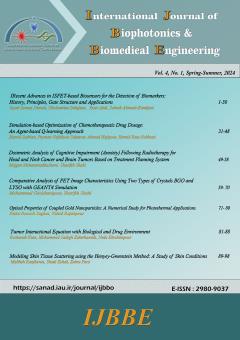Modeling Skin Tissue Scattering using the Henyey-Greenstein Method: A Study of Skin Conditions
Subject Areas : Interaction of Light with Tissue and Cells
Maliheh Ranjbaran
1
*
![]() ,
Shadi Zokab
2
,
Zahra Farsi
3
,
Shadi Zokab
2
,
Zahra Farsi
3
1 - Central Tehran Branch, Islamic Azad university, Tehran, Iran
2 - Department of Physics, Central Tehran Branch, Islamic Azad University, Tehran, Iran
3 - Department of Physics, Central Tehran Branch, Islamic Azad University, Tehran, Iran
Keywords: Back-scattering, Henyey-Greenstein, Skin conditions, Spectral reflectance, Zemax software,
Abstract :
Spectral reflectance from layered skin tissue as a function of wavelength can provide valuable information about the skin's optical properties for diagnosing skin conditions. Monte Carlo and Henyey-Greenstein (HG) are two methods to model scattering in skin layers. However, the HG method is a simpler and widely used technique that assumes a single parameter to characterize the scattering phase function. In this study, we conducted simulations of scattering in six-layered skin tissue using Zemax software based on HG method. Our observations revealed increased penetration depth and back-scattered reflectance as the wavelength increased. We investigated reflectance patterns in different skin conditions by simulating mild solar damage, mild chronic dermatitis, and Mild solar damage with chronic inflammation. We recorded differences in the maximum intensity of reflected light in each condition. Additionally, we compared the backscattered reflections produced by incoherent and coherent light sources. The results of our HD simulation-based studies suggest that incoherent sources at infrared wavelengths could be advantageous for the analysis of skin disorders.
[1] N. Kollias, G. Zonios, G. N. Stamatas, Fluorescence spectroscopy of skin. Vibrational Spectroscopy, Vol. 28, pp. 17-23, 2002.
[2] I. V. Meglinskii, Monte Carlo simulation of reflection spectra of random multilayer media strongly scattering and absorbing light. Quantum Electronics, Vol. 31, pp. 1101, 2001.
[3] 1. T. Maeda, N. Arakawa, M. Takahashi, & Y. Aizu, “Monte Carlo simulation of spectral reflectance using a multilayered skin tissue model”. Optical review, Vol. 17, pp. 223-229. 2010.
[4] I. V. Meglinski, S. J. Matcher, Computer simulation of the skin reflectance spectra. Computer methods and programs in biomedicine, Vol. 70, pp. 179-186, 2003.
[5] T. Binzoni, T. S. Leung, A. H. Gandjbakhche, D. Ruefenacht, & D. T. Delpy, “The use of the Henyey–Greenstein phase function in Monte Carlo simulations in biomedical optics”. Physics in Medicine & Biology, Vol. 51, pp. N313, 2006.
[6] L. G. Henyey, J. L. Greenstein, Diffuse radiation in the galaxy. Astrophysical Journal, Vol. 93, pp. 70-83, 1941.
[7] C. Ash, M. Dubec, K. Donne, & T. Bashford, “Effect of wavelength and beam width on penetration in light-tissue interaction using computational methods”. Lasers in medical science, Vol. 32, pp. 1909-1918, 2017.
[8] O. Kim, J. McMurdy, C. Lines, S. Duffy, G. Crawford, M. Alber, Reflectance spectrometry of normal and bruised human skins: experiments and modeling. Physiological measurement, Vol. 33, pp. 159-175, 2012.
[9] H. Funamizu, T. Maeda, S. Sasaki, I. Nishidate, Y. Aizu, Simulation of spectral reflectances in human skin tissue using ray tracing and GPU-based Monte Carlo method. Optical Review, Vol. 21, pp. 359-363, 2014.
[10] V. M. Petnikova, E. V. Tret'yakov, V. V. Shuvalov, Stability of the Henyey—Greenstein phase function and fast path integration under conditions of multiple light scattering. Quantum Electronics, Vol. 36(11), pp. 1039, 2006.
[11] I. N. Melnikova, Z. M. Dlugach, T. Nakajima, K. Kawamoto, Calculation of the reflection function of an optically thick scattering layer for a Henyey–Greenstein phase function. Applied optics, Vol. 39(24), pp. 4195-4204. 2000.
[12] N. S. Żołek, S. Wojtkiewicz, A. Liebert, Correction of anisotropy coefficient in original Henyey Greenstein phase function for Monte Carlo simulations of light transport in tissue. Biocybernetics and Biomedical Engineering, Vol. 28, pp. 59-73, 2008.
[13] A. P. Popov, A. V. Priezzhev, & R. Myllyla, “Effect of spectral width on short laser pulse propagation through upper layers of human skin: Monte Carlo simulations”. Proc. SPIE 5319, Laser Interaction with Tissue and Cells XV, (1 July 2004).
[14] V. Tuchin, Tissue Optics: Light Scattering Methods and Instruments for Medical Diagnosis, SPIE Press, Washington, 2000.
[15] T. L. Troy, S. N. Thennadil, Optical properties of human skin in the near infrared wavelength range of 1000 to 2200 nm. Journal of biomedical optics, Vol. 6, pp. 167-176, 2001.
[16] M. D. Francisco, W. F. Chen, C. T. Pan, M. C. Lin, Z. H. Wen, C. F. Liao, & Y. L. Shiue, "Competitive real-time near infrared (NIR) vein finder imaging device to improve peripheral subcutaneous vein selection in venipuncture for clinical laboratory testing. Micromachines", Vol. 12, pp. 373-1-21, 2021.
[17] S. H. Tseng, P. Bargo, A. Durkin, & N. Kollias, "Chromophore concentrations, absorption and scattering properties of human skin in-vivo", Optics express, Vol. 17, pp. 14599-14617, 2009.
[18] V. Mircheva, E. Borisova, T. Genova, P. Troyanova, L. Avramov, A. Markovski, Diagnosis of skin lesions through prototype clinical device with diffuse reflectance spectroscopy. Journal of Physics: Conference Series, Vol. 2487, pp. 012026-1-5, 2023.
[19] P. Hanrahan, W. Krueger, Reflection from layered surfaces due to subsurface scattering. In Seminal Graphics Papers: Pushing the Boundaries, Vol. 2, pp. 279-288, 2023.
[20] N. S. Hanasil, R. K. R. Ibrahim, F. H. Mustafa, F. K. C. Harun, A. A. Tan Evaluation of NIR LED and laser diode as a light source in diffuse reflectance spectroscopy system for intravenous fluid infiltration detection under dermis layer of skin phantom. Measurement, Vol. 223, pp. 113707-1-6, 2023.
[21] M. A. Dall Agnol, R. A. Nicolau, C. J. de Lima, E. Munin, Comparative analysis of coherent light action (laser) versus non-coherent light (light-emitting diode) for tissue repair in diabetic rats. Lasers in medical science, Vol. 24, pp. 909-916, 2009.

